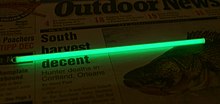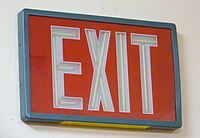Radioluminescence

Radioluminescence is a way that some radioactive materials produce light. It is seen around some very strong sources of radiation. Radioluminescent paint is used for clock hands and signs to make them easier to see in the dark.
How it works[change | change source]
Radioluminescence happens when an atom or molecule gets energy from ionizing radiation. The energy is released as a photon of light.[1] A chemical that releases one type of light when it gets energy from ionizing radiation is called a phosphor. Radioluminescent materials are made by mixing something radioactive with a phosphor.
Uses[change | change source]


Radioluminescence is mostly used to make things visible in the dark. Most radioluminescent paint has radium, promethium, or tritium.
Radium[change | change source]
Radium was the first element used in radioluminescent paint. It was first used in 1908. The green light was made by mixing radium with zinc sulfide and copper. Other metals such as manganese and silver were used to make different colors of paint. Radium stopped being used in paint in the 1960s.[2]
Promethium[change | change source]
The isotope promethium-147 replaced radium in radioluminescent paint after the 1960s. It is less dangerous than radium. However, promethium-147 has a half-life of 2.62 years, so it does not last as long as radium or tritium.[3]
Tritium[change | change source]
Most radioluminescent materials now use tritium, which is a radioactive isotope of hydrogen. It is also less dangerous than radium, but it is a gas, so it cannot be mixed in paint. Tritium is put inside of glass tubes that have phosphor on the inside.
References[change | change source]
- ↑ Lauer, T. (18 June 2015). "Radioluminescence (RL)". Encyclopedia of Scientific Dating Methods. Springer, Dordrecht. doi:10.1007/978-94-007-6304-3_104.
- ↑ Tykva, Richard; Sabol, Jozef (1995). Low-Level Environmental Radioactivity: Sources and Evaluation. CRC Press. pp. 88–89. ISBN 1566761891.
- ↑ Kondev, F. G.; Wang, M.; Huang, W. J.; Naimi, S.; Audi, G. (2021). "The NUBASE2020 evaluation of nuclear properties" (PDF). Chinese Physics C. 45 (3): 030001. doi:10.1088/1674-1137/abddae.
